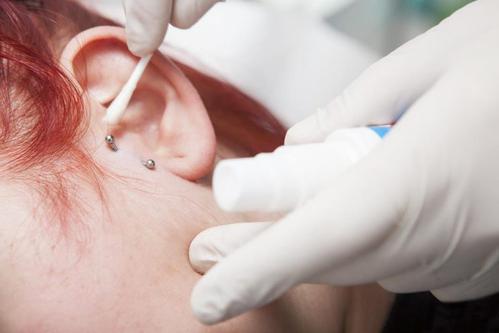Best Ways to Reduce Pain Three Days After Having Ears Pierced
Ear piercing is one of the main beautification actions done by both men and women. But it's important to acknowledge that ear piercing is painful at the initial stage. If the newly pierced ear gets infected with germs, it can result in irritation, pain, swelling, and discomfort. The chances of feeling pain depend on the hygiene exhibited during the piercing process all the way to the complete healing time.
You must make sure tools like needles and piercing guns are sterilized before use. Additionally, the piercer must also observe hygiene. Piercings done on the cartilage hurts more and takes longer to heal than those on earlobes. Three days after piercing, sores might erupt which are part of the healing process. The pierced area may swell and become reddish but if hygiene is maintained and no infection happens, the ears usually heal within 12 weeks.
Tips for Reducing Pain After Having Ears Pierced
Below are tips on how you can deal with such pain.

- Leave the Earring in Your Ear
Immediately after the piercing, starter earrings are inserted. You should not remove them until the pierced part has healed completely. Normally a lobe piercing heals in six weeks while ear cartilage piercing heals after eight to twelve weeks. During this time the hypoallergenic earrings should not be removed. Treatment should be done while they are in situ.
- Don't Touch Your Ear Often
Touching your pierced ear too often is a big no! You might not remember to clean your hand using antibacterial soap each time you touch your ear. Frequent touching of those areas can introduce bacteria or other infectious pathogens. If possible, only touch your ears when disinfecting those pierced areas.
- Keep the Area Infection-free
The infection has a detrimental effect on any skin opening. A habit of keeping your pierced ear as clean possible is vital. Do not let a day pass without swabbing that area using hydrogen peroxide. Cleaning helps to kill germs and other pathogens. You should clean them using plenty of water and soap. Ensure that you rinse that area well when showering to get rid of any debris between your earring and the pierced surface.
- Don't Clean the Pierced Area Too Much
Although keeping the areas clean is vital, cleaning should not be overdone. Doing it too many times a day can be detrimental. A lot of alcohol, soap, and astringents used when cleaning can cause irritation or disturb the healing process.
- Avoid Pressure on the Ear
Pressure mostly results from how you position yourself when you sleep. For the first week, it is advisable to sleep on your back. This sleeping position helps avoid putting pressure on the newly pierced ear which can result in more pain and swelling. Additionally, avoid the use of earmuffs, swimming, or anything that can put pressure on the very areas.

Vital Tips Regarding Ear Infections
Infection is something that can make you wonder how long are ears sore after the piercing is supposed to last. Below are more details regarding ear infections.
1. How to Know If Your Ear is Infected
An infection affects the healing process and that is why you need to be informed of how to maintain top-notch hygiene. For ear infections, you must be able to differentiate between the new piercing effects and infection effects. For infection effects, below are some of the symptoms you are likely to experience.
- The pierced area becomes red
- Fluid discharge, especially pus, is seen
- Severe prolonged pain
- Lacerations
- Fever or stomach upsets
Any or all of these symptoms are indications that your newly pierced ear is infected.
2. How to treat ear infection
- Apply an Ice Pack
Ice packs are used to treat swelling. When an ice pack is placed on a swollen pierced area, it helps reduce the swelling and fight infection. Note, an ice pack should never be placed directly to your skin. It can cause damage to the skin cells, so always put a cloth or fabric between your skin and the ice packs.
- Rinse Your Ear with Saline Solution
Saline solution helps fight bacteria. You can get saline from piercing parlors or chemists. Additionally, diluting about a one-eighth teaspoon of non-iodized salt in a glass of water can be a perfect homemade saline solution. Use a piece of cloth or a cotton swab, submerge it in the saline solution, and press against the pierced area for about 20 minutes. This should be done twice per day for better infection fighting.
- Over-the-counter Anti-inflammatory Drugs
When ear inflammation worsens due to infection, think of using over the counter drugs. They will help relieve the pain, reduce the inflammation and avoid other primary side effects like fever. Infections can cause significant effects which can delay the healing process. But OTC medications should be taken 24 hours before a piercing and for seven days after the piercing.
- Go to Your Piercer or Doctor
In case you lack information on how to handle infection, consider visiting a doctor or an experienced ear piercer. These people can give you good advice on your treatment. In cases where the infection is more severe, your doctor or piercer can opt to do the initial treatment and cleaning as they access the area. Remember, they have dealt with these situations before, and thus stand a better chance to help.
Although there has been a lot here about infections, pain, swelling, and other post ear piercing effects, it does not mean piercing is very risky. All you need to do is follow precautions as advised by a piercer or a doctor. Ear piercing is a nice beautification action that does not disappoint.
